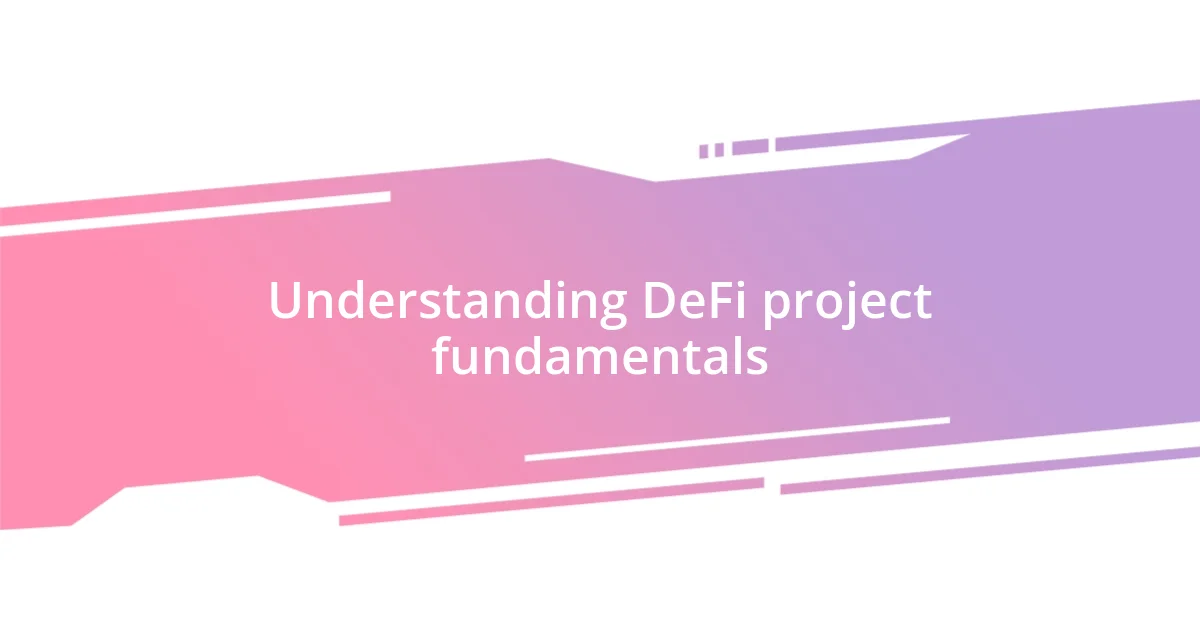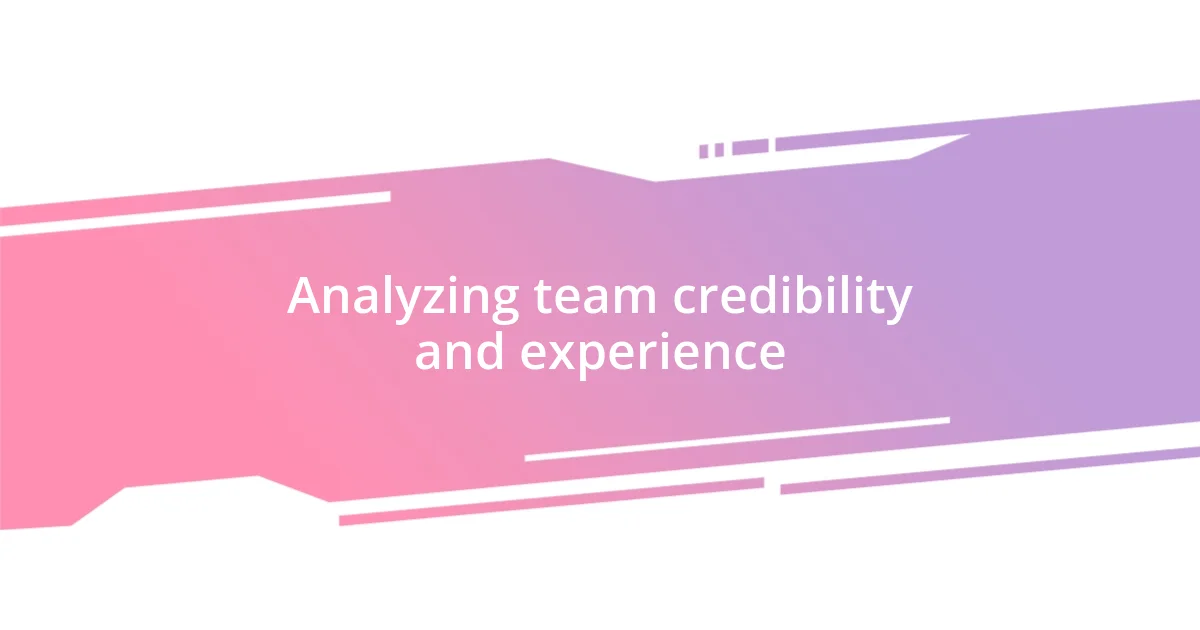Key takeaways:
- Choosing a DeFi project requires evaluating its core purpose, technology, and team credibility to ensure community trust and engagement.
- Understanding a project’s utility and implementation plans is essential for its viability and long-term sustainability.
- Active community involvement and open developer communication significantly enhance a project’s credibility and user commitment.

Understanding DeFi project fundamentals
When diving into DeFi projects, I always begin by examining their core purpose and utility. It’s fascinating how many projects aim to solve real-world problems or enhance financial access. Have you ever thought about why some projects resonate more with users than others? I’ve found that projects with a clear mission often attract a more dedicated community.
Another fundamental aspect is the technology behind the project. I remember my first encounter with a DeFi platform that boasted of unique smart contract capabilities. Their transparency and security measures were impressive, but what struck me most was how they communicated this information. After all, a project’s success hinges not just on innovative ideas but also on user trust. How well does the team behind a project explain its workings, and do they engage with their users meaningfully?
Don’t overlook the importance of the team leading the project. I’ve seen promising ideas falter simply because the team lacked experience or transparency. Evaluating the founders’ backgrounds and their track record can give invaluable insights. How many times have you entered a project feeling excited but later wished you’d done more research on the team? I know I’ve been there, and it’s a lesson I carry with me when choosing future investments.

Evaluating project utility and purpose
When I evaluate a DeFi project’s utility, I often ask myself, “What tangible benefits does this project offer to its users?” For instance, I remember researching a lending platform that allowed users to earn interest on their crypto assets. The idea of putting my idle coins to work was thrilling. The utility should resonate with real-world applications; if it does, the chances are higher that it will find an audience.
Furthermore, I find it essential to consider the project’s purpose. For example, I once stumbled upon a decentralized insurance protocol. It aimed to address issues that traditional insurance often overlooks, like claim transparency. Their mission to create a fairer system made me feel invested, emotionally connecting me to their goals. It’s incredible how the purpose behind the project can influence not just its viability but also a user’s commitment to it.
Lastly, understanding how a project plans to implement its utility can reveal much about its potential success. I once followed a project that started with a brilliant concept but lacked clear execution plans. As I watched, the enthusiasm dwindled because the community felt unsure about the path forward. This experience solidified my belief that robust strategies and transparent communication are crucial for a project’s long-term sustainability.
| Aspect | Details |
|---|---|
| Utility | Tangible benefits for users |
| Purpose | Real-world applications and emotional connections |
| Implementation | Clear execution plans and strategies |

Analyzing team credibility and experience
When evaluating the credibility and experience of a DeFi team, I focus on their professional backgrounds. It’s striking how much a founder’s history can shape a project’s trajectory. For example, I encountered a DeFi protocol led by individuals who had previously built successful startups. Their experience gave me confidence, indicating that they were likely well-equipped to navigate challenges and drive innovation. Digging deeper into the team’s past helps create a clearer picture of the project’s potential.
Here are key aspects to consider when analyzing team credibility and experience:
- Founders’ Track Record: Investigate their previous projects and successes.
- Industry Recognition: Look for awards or recognition in the crypto space.
- Technical Skills: Ensure the team includes proficient developers and blockchain experts.
- Transparency: A credible team openly shares its journey, challenges, and updates.
- Community Engagement: Check if they interact with their user base and listen to feedback.
I’ve also learned that how a team communicates their vision matters significantly. I once followed a project where the team was approachable and responsive. Their willingness to engage with the community not only established trust but also fostered a sense of belonging. This connection often reflects a team’s commitment to the project, making it essential for me to factor in their communication style while assessing credibility.

Assessing market potential and competition
When I’m assessing the market potential of a DeFi project, I often think about its target audience. I remember evaluating a project that aimed to disrupt traditional finance, but I questioned whether they truly understood the needs of their potential users. It’s vital to grasp if a project can attract and retain a substantial user base; otherwise, growth becomes a distant dream. Wouldn’t you agree that a project that connects with its audience stands a better chance of thriving?
Competition analysis is another crucial factor in my evaluation process. I once looked into a yield farming protocol that appeared promising until I discovered several identical projects emerging simultaneously. This redundancy made me wonder if there was enough demand for all these solutions. Understanding how a project differentiates itself can help me predict its longevity amidst a sea of alternatives. Have you noticed how a unique selling proposition can often be a deciding factor in a project’s success?
Lastly, I consider market trends and their implications for a project’s trajectory. I vividly recall analyzing a DeFi application focused on NFTs when the market seemed saturated, yet the project still gained significant traction. It taught me how innovative approaches can change the game, even in competitive markets. So, when assessing market potential, I always keep an eye on the evolving landscape and how adaptable the project is to shifting demands. Isn’t it fascinating how agility in the ever-changing DeFi space can truly dictate success?

Reviewing tokenomics and incentives
When I look at the tokenomics of a DeFi project, I dive into how the token distribution is structured. For instance, I once scrutinized a project where a significant portion of tokens was allocated to early investors and team members, leaving little room for community engagement. This imbalance made me wary—what incentive would regular users have to participate actively? If the economic model feels off, it can undermine trust and participation.
Incentives play a pivotal role in tokenomics. Take liquidity mining, for instance. I remember getting excited about a project that offered enticing rewards to liquidity providers. However, after some time, the rewards were slashed unexpectedly, disappointing many in the community, including myself. It highlighted the importance of sustainable incentives—long-term growth requires appealing rewards that don’t vanish overnight. How often do we see projects that neglect this crucial element, chasing short-term gains instead?
Lastly, I always examine the utility of the token itself. I had an eye on a protocol that promised extensive use cases for its token, like governance voting and staking. When I actually engaged with the platform, the functionalities were there, but they felt limited and somewhat cluttered. This experience reminded me that a token’s utility shouldn’t just exist on paper. Does the token’s design truly enhance user experience and foster a vibrant ecosystem? Understanding this dynamic is essential for gauging the project’s real value and long-term viability.

Exploring community engagement and support
When exploring community engagement and support, I’ve found it fascinating how active communities can make or break DeFi projects. I remember being part of a Discord group for a new DeFi protocol, where enthusiastic discussions and a genuine sense of camaraderie fostered an environment of trust and collaboration. Wouldn’t you agree that when community members feel connected, they’re more likely to contribute positively, whether through feedback, promotion, or troubleshooting?
I’ve also noticed that the way developers engage with their communities speaks volumes about a project’s integrity. For example, there was a project I followed closely that hosted frequent AMAs (Ask Me Anything sessions) on social media. During these interactions, the team was open and responsive to community questions and concerns, which instilled a strong sense of transparency. Isn’t it reassuring when you see developers prioritizing direct communication? This level of engagement can create an enthusiastic base of supporters who feel valued and informed.
Another aspect worth considering is the presence of community-driven initiatives. I recall participating in a community-led proposal for a new feature in a DeFi application. Seeing my suggestions take shape felt empowering and solidified my commitment to the project. This experience reinforced my belief that when projects embrace community input, they can cultivate deeper loyalty and innovation. How often have you come across projects that overlook this essential connection to their users? It’s clear to me that strong community support can be a game-changer in the DeFi landscape.













